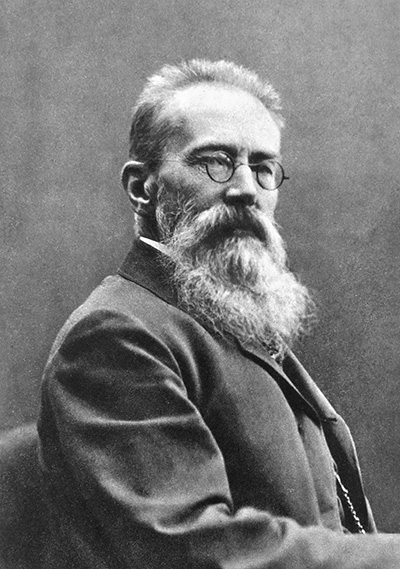Nikolai Rimsky-Korsakov

- Born: March 18, 1844, Tikhvin, near Novgorod
- Died: June 21, 1908, St. Petersburg, Russia
Russian Easter Overture, Op. 36
- Composed: 1888
- Premiere: December 15, 1888, St. Petersburg, conducted by the composer
- Instrumentation: 3 flutes (incl. piccolo), 2 oboes, 2 clarinets, 2 bassoons, 4 horns, 2 trumpets, 3 trombones, tuba, timpani, bass drum, crash cymbals, glockenspiel, suspended cymbals, tam-tam, triangle, harp, strings
- CSO notable performances: First CSO Performance: November 1925, Fritz Reiner conducting. Most Recent Performances: (CSO subscription) October 2013, Rafael Payare conducting; (CSO/CSYO Side-by-Side concert) April 2015, John Morris Russell conducting
- Duration: approx. 15 minutes
Rimsky-Korsakov loved the old ways. Born and raised in Tikhvin, a city some hundred miles east of St. Petersburg that was known for its monastery, he often recalled later in life the sound of the monastery bells tolling over the town and the tales of the traditional peasant life that his grandmothers—one a serf, the other a priest’s daughter—told him as a boy. It is not surprising, therefore, that he turned to one of the great annual events in 19th-century Russia as a subject for one of his colorful orchestral compositions—“The Bright Holiday,” Easter. Early in 1888 in St. Petersburg, shortly after the Capriccio espagnol had been premiered, he began an overture based on themes associated with the Easter celebration from the Obikhod, a collection of the best-known canticles of the Orthodox Church. He completed the score that summer during a country retreat at Nezhgovitsi, near Luga, when he was also finishing Scheherazade. He led the premiere of the Russian Easter Overture in St. Petersburg’s Club of Nobility on December 15th, in the middle of Advent.
Rimsky-Korsakov explained the musical progress of the Russian Easter Overture in his autobiography, My Musical Life: “The rather lengthy, slow introduction to the Overture, on the theme ‘Let God Arise!’ alternating with the ecclesiastical theme ‘An Angel Wailed,’ appeared to me, in its beginning, as it were, the ancient Isaiah’s prophecy concerning the resurrection of Christ. The gloomy colors seemed to depict the Holy Sepulcher before it had been filled with ineffable light at the moment of Resurrection. The beginning of the Allegro, based on ‘Let Them That Hate Him Flee Before Him,’ suggested the holiday mood of the Greek Orthodox Church service on Christ’s matins; the solemn trumpet voice of the Archangel was replaced by a tonal reproduction of the joyous, almost dance-like bell tolling, alternating now with the sexton’s rapid reading and now with the conventional chant of the priest’s reading the glad tidings of the Evangel. The ‘Obikhod’ theme ‘Christ Is Arisen,’ which forms a sort of subsidiary part of the Overture, appears amid the trumpet blasts and the bell tolling, constituting also a triumphant coda.”
In addition to the solemn Christian aspects of the Easter holiday, Rimsky also wove into his Overture the exuberant joy that had been associated with the pagan celebration of springtime rebirth. “In this Overture,” he continued in his autobiography, “there were thus combined reminiscences of the ancient prophecy, of the Gospel Narrative and also a general picture of the Easter Service with its ‘pagan merry-making.’ The capering and leaping of the Biblical King David before the Ark, do they not give expression to a mood of the same order as the mood of the idol-worshippers’ dance? Surely the Russian Orthodox ‘Obikhod’ is instrumental dance music of the Church, is it not? And do not the waving beards of the priests and sextons clad in white vestments and surplices, and intoning ‘Beautiful Easter’ transport the imagination to pagan times? And all those Easter loaves and twists and the glowing tapers.... This legendary and heathen side of the holiday, this transition from the gloomy and mysterious evening of the Passion Saturday to the unbridled pagan-religious merry-making on the morn of Easter Sunday, is what I was eager to reproduce in my Overture.”
Rimsky-Korsakov thought that to appreciate the Overture “even ever so slightly, it is necessary that the hearer should have attended Easter morning service at least once... in a cathedral thronged with people from every walk of life, with several priests conducting the service.” He asked his friend, Count Golyenischeff-Kootoozoff, to write a description of the traditional Easter service for those unfamiliar with the event but was not pleased with the result, so he prefaced the published score with two verses he chose from the Bible. The first (Psalm 68, “Let God arise, let His enemies be scattered”) is the text for one of the chant melodies he quoted in the Overture. The other is the account in the Gospel of St. Mark describing Mary Magdalene and Mary arriving at the empty tomb on Easter morning. To these verses, Rimsky added his own lines: “And the joyful tidings were spread abroad all over the world, and they who hated Him fled before Him, like vanishing smoke. ‘Resurrexit!’ sing the chorus of angels in heaven to the sound of the archangels’ trumpets and the fluttering of the wings of the seraphim. ‘Resurrexit!’ sing the priests in the temples, in the midst of the clouds of incense, by the light of innumerable candles, to the chiming of triumphant bells.”
—Dr. Richard E. Rodda